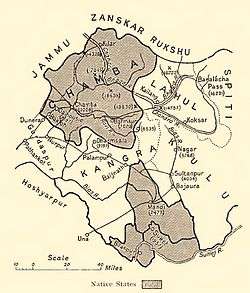Hill States of India
The Hill States of India were princely states lying in the northern border regions of the British Indian Empire.
History
During the colonial Raj period, two groups of princely states in direct relations with the Province of British Punjab became part of the British Indian Empire later than most of the former Mughal Empire, in the context of two wars and an uprising.
For its princely rulers the informal term Hill Rajas has been coined. After the independence and split-up of British India, the Hill States acceded to the new Union of India and were later divided between India's constituent states of Punjab (proper), Haryana and Himachal Pradesh.
Simla Hills

28 princely states (including feudatory princes and zaildars) in the promontories of the western Himalaya were named after Shimla as the Simla Hill States.[1] These states were ruled mainly by Hindu Rajputs.[2][3] Their inhabitants were mainly Hindu with a few Buddhists; the local languages were Hindi, Punjabi, Urdu and various Pahari dialects.
Three quarters of the about 4,800 square miles (12,000 km2), on both sides of the Sutlej river, was the territory of the Raja (earlier Rana) of Bashahr. The direct tributaries of Bashahr were:
- the Thakur of Khaneti
- the Thakur of Delath.
The other, all far smaller, princely states, including a few with some petty dependencies of their own, were further south, on the left bank of the Sutlej:
- the Rana of Balsan
- the Thakur of Beja
- the Rana of Bhaji /Bhajji
- a prince of Bhagat
- the Raja of Bilaspur (formerly Kahlur = Kehloor), entitled to an 11-guns salute
- the Rana of Darkoti(i) = Darkoti
- the Rana (Shri) of Dhami
- the Raja Rana (ex Rana) of Jubbal. The Jubbal state had two tributaries:
- the Thakur (sahib) of Dhadi, initially tributary to Tharoch, then to Bashahr and finally in 1896 to Jubbal.
- (title?) Rawin = Rawingarh
- the Raja (formerly Rana) of Keonthal. Furthermore, the feudal pyramid included five Keonthal zaildars (jagirdars collecting a special tax):
- the Thakur of Kunihar
- the Rana of Kuthar
- the Thakur of Mahlog
- the Rana of Mangal
- the Raja of Nalagarh
- the Thakur (or Rai Mian?) of Sangri
- the Thakur (originally titled Rana up to the occupation by the Gurkhas, and Thakurs from 1815 to 1929) of Tharhoch = Tiroch
NB - For various of the entities above, the authentic title of the chieftain is missing. While some of the lowest ranking may have had none, for the princes that can merely be due to insufficient sources available
The princely states of the Simla Hills all ultimately became part of the modern Indian state of Himachal Pradesh.
States of the Punjab Hills
Some nearby Hindu and Sikh states include :
- HH the Raja (Saheb) of Chamba, entitled to an 11 gun salute
- HH the Raja of Mandi, entitled to an 11 gun salute
- HH the Raja of Suket, entitled to an 11 gun salute
- HH the Maharaja (until 1913 Raja) of Tehri Garhwal State (in Uttar Pradesh), entitled to an 11 gun salute
- HH the Raja of Siba, no salute, as Siba was not fully part of the British Indian Empire, only Siba Jagir (Jagir of Mian Devi Singh) up to Kotla.
- etc.
References
External links and Sources
- Indian Princely States website
- Punjab State Gazetteer [then Punjab was much larger], vol. VIII, Gazetteer of the Simla Hill States 1910
- Himachal Pradesh State's official website and various links therefrom (click on map or names) to official sites of the state's districts